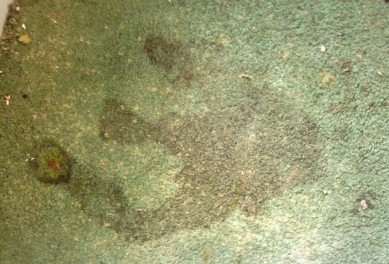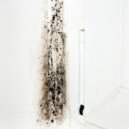Find a pre-screened local mold removal specialist Free Estimate
Find a Mold Specialist Now
Click or Call, Toll-Free 24/7
Cleaning Mold From Carpet
There is a common question many homeowners ask when they face a mold remediation in their home. Is cleaning mold from carpet worth pursuing or not? The answer is usually no, but it is always a good idea to explore restoration options when dealing with carpet that has been affected by mold.
The most important factor concerns the value of the carpet. Is it a natural fiber such as wool, silk, and bamboo, or maybe from an animal skin like a bear? Or is it manufactured from a synthetic fiber like nylon or acrylic? The amount of the mold present is another issue. Is it just a small corner near the wall, or does the mold cover a larger area? These are all things that come into play when considering whether to attempt to clean mold from carpet.
Understanding Carpet Construction
Although carpet construction techniques may vary slightly from one manufacturer to another, the actual way carpet is made is basically the same. The first component is called the face yarn, that’s the part of the carpet that is walked on, the top layer. Next is the primary backing, that which the yarn is woven into. This primary backing usually has latex as part of its make-up. After this comes a secondary backing, again containing latex. Latex is an organic compound and a food source for mold.
There are two types of yarn faces (top layers):
- Synthetic material - Most of today’s modern carpets found in residential homes and commercial buildings are made of synthetic, or man-made, materials.
- Organic/natural material - Such as bamboo, wool, silk, cotton, and animal skins.
Synthetic Material Carpets
When you find mold growing on carpet made from synthetics, usually the face yarn (the part you walk on) will not itself be damaged by the mold because mold doesn’t consume synthetic materials. The mold will damage the carpet’s primary and secondary backing layers, which in turn ruins the carpet.
Most carpets found in residential homes and commercial buildings are made of synthetic, or man-made, materials. However, almost all carpet backings contain latex. If you see mold on a carpet, you need to inspect the backside of the carpet. If mold covers a large area of the backing, it’s time to replace the carpet. The costs involved with cleaning mold from carpet far outweighs the cost of its replacement. Carpet is extremely porous. This allows the mold to penetrate between and around the different layers and fibers in the carpet, which makes it next to impossible to access and successfully remove the mold completely.
Mold Below The Carpet
One very important thing to do if you discover mold on your carpet; you need to carefully inspect the subfloor under the carpet, and if there is any carpet padding, under it also. Mold below the carpet must be addressed as well.
Area Rugs
If the carpet is an area rug that can be moved, take it outside and hang it in direct sunlight. Sunlight will help kill mold spores and dry up any moisture present in the carpet. If possible, leave it outside in the sun for several days, reversing the side out every so often.
Organic/Natural Material Carpets
Carpets made from organic/natural fibers like bamboo, cotton, animal, or animal skins are made in much the same way as carpets containing synthetic/man-made fibers (synthetic fibers can be nylon, polypropylene, etc.). The difference, besides cost, is that mold will attack organic/natural fiber carpets’ face yarns. Again, face yarns are the part of the carpet you walk on (the primary and secondary backings hold the face yarns together).
Whenever mold is discovered on any carpet made from organic/natural material or animal skins, because of the high value of these carpets, a carpet specialist who deals with organic/natural carpets should inspect them before they are discarded. Valuable organic/natural fiber carpets may be able to be restored rather than being disposed of.
How To Clean Mold From Carpet DIY
When the carpet cannot be carried outside, the first thing you should do is inspect the backside of the carpet. If only a small amount (less than 3 square feet) of mold can be seen on the backing you can attempt to remove it. If there is more than that, the carpet should be discarded.
First, you need to get rid of the moisture. Open all of the windows and doors in the room with the moldy carpet. This will allow airflow to lessen the humidity that mold thrives on. If the room has no windows, place a fan near the door and blow air OUT of the room (never direct airflow across any mold).
Next you want to dry the carpet. Putting baking soda or talc-free baby powder on the affected areas can do this. Make sure that if you do use baby powder, that it is talc-free. Another possibility for this process would be to use cat litter.
After removing any moisture, scrub the moldy areas with white vinegar and a stiff brush. Vinegar will kill most species of mold. Use only white vinegar, as it will not stain the carpet. Thoroughly wet both sides of the carpet that displays mold contamination. After allowing the solution to dwell for at least 30 minutes, extract as much moisture as you can using a wet-vac or shop-vac. Use a fan to blow air across the surface and underneath the carpet to speed drying. After the treated areas are dry, vacuum the entire carpet with a HEPA-rated vacuum to collect any leftover mold spores that may have become airborne and then settled.
You can also attempt to clean mold from carpet using a commercial cleaning product. If you do choose to use a commercial product, be sure that it doesn’t contain bleach or chlorine dioxide. Products with these ingredients may alter the color of the carpet. If the carpet is made out of a natural fiber, animal or plant based, avoid these types of cleaning products. Also avoid enzyme-based or alkaline products as these products can damage the fibers. Yet another warning is to never over wet a natural fiber carpet. Over wetting can cause secondary damage like shrinking and browning.
Carpet Mold Prevention
The best way to avoid mold on carpet is to make sure the carpet does not get wet or stay wet for an extended period of time, 24 hours or less if possible. Increase ventilation in rooms containing carpet by opening windows or adding a fan. If there are no windows, leave a lower wattage light on several days a month. Even low-powered nightlights can be effective. If high humidity is an issue, consider running a dehumidifier in the area, especially overnight. And vacuum carpets regularly. Vacuuming removes potential organic food sources and mold spores that may be brought into the home from outdoors.
Professional Advice On Cleaning Mold From Carpet
Mold is extremely hard to completely remove from carpets. It is really next to impossible. You should only really consider cleaning mold from carpet if the carpet is exotic, expensive, or next to impossible to replace. Also, certified mold remediation specialist should always be contacted before attempting to do any major mold removal projects. To consult with a pre-qualified mold removal specialist in your area, follow this link. These specialists will come to your home, inspect all areas of concern, and provide you with a free, no-obligation estimate to solve your mold problem with your safety and convenience in mind.
Return From Cleaning Mold From Carpet To Home Page
Sources:
EPA Mold Guidelines
IICRC
Free Home Inspection By A Mold Removal Specialist
Search This Website
Recent Articles
-
See Our 5 Recommended Mold Removal Companies in Covington, KY
Apr 16, 25 12:59 PM
-
See Our 5 Recommended Mold Removal Companies in Wheaton, IL
Jun 20, 24 10:33 AM
-
See Our 5 Recommended Mold Removal Companies in Aberdeen, SD
Oct 08, 21 04:05 PM






